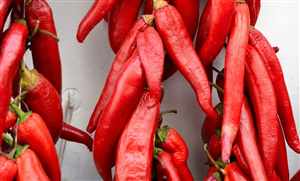Cayenne Pepper (Capsicum annuum), Guinea spice, red hot chili pepper, aleva, bird pepper
Main Facts about Cayenne Pepper

Using Cayenne Pepper
The active ingredient in Cayenne pepper is capsaicin, which acts as a stimulant. Cayenne is recommended for its soothing and restorative effects on the digestive system. For many years it has been use to cure flatulence and diarrhea. Can aid digestive system by stimulating the production of saliva and gastric juices. For digestive problems, capsaicin may be taken in capsules (30 to 120 mg, 3 times daily). Cayenne helps boost your metabolism and induces the body to burn off more fat. A few studies suggest that cayenne supplements may help suppress appetite and help people feel full. That is why Cayenne is a major part of a now popular weight loss diet. Cayenne can also be used externally in liniments to relieve lower back pain, sciatica or shingles, and as a remedy for painful joints. It slightly irritates the skin and stimulates blood flow to the area, which reduces inflammation. Cayenne does not cause skin redness because it affects the sensory nerves and not the capillaries. It increases blood circulation and warmth throughout the body. For shingles, psoriasis, arthritis, or muscle pain, capsaicin cream (0.025 to 0.075% capsaicin) may be applied directly to the affected area up to 4 times a day. Pain may get slightly worse at first. But then the pain may get better over the next few days. Capsaicin should be applied regularly several times a day. It usually takes 3 to 7 days before you notice substantial pain relief. You can use Cayenne infused oil with similar results. To relieve a toothache, clean out the cavity , make a small cotton plug saturated with Cayenne oil. Press it into the cavity. It will burn at first, but it will give you a lasting relief. Cayenne pepper is a good home remedy for cold and fever. It can be used as a gargle for a sore throat (and as a remedy for a hangover).Cayenne Pepper is a remedy for: Cold and flu, Arthritis, Weight loss
Caution!
Do not apply capsaicin cream to cracked skin or open wounds. Do not give cayenne to children under 2. Capsaicin capsules may cause stomach irritation. People who are allergic to latex, bananas, kiwi, chestnuts, and avocado may also have an allergy to cayenne. Eating cayenne in food is considered safe during pregnancy. But pregnant women should not take cayenne as a supplement. Breastfeeding women should avoid cayenne both as a spice and a supplement. Consumption of Cayenne can be dangerous for those people with intestinal disorders such as duodenal ulcers or chronic bowel diseases. Even in individuals with healthy digestive systems, Cayenne in excessive amounts can cause severe stomach upset and even kidney damage. In normal culinary uses, however Cayenne should not cause problems.Cooking with Cayenne Pepper
Cayenne is used in cooking spicy dishes, as a powder or in its whole form. Cayenne powder is used to make liniments and oils. Cayenne extracts can be taken in capsule and liquid form. To make a powerful liniment for sprains and congestion, gently boil 1 tablespoon of Cayenne peper in 1 pint of cider vinegar. Bottle the unstrained liquid while it's hot.How to grow Cayenne Pepper
Cayenne grows best in rich soil. It has a long growing season (14 to 18 weeks), so you should start it indoors from seed. The plants can be set in the garden when the soil has warmed, about two weeks or more after the last frost. The plants will need plenty of water during the early stages of growth. Cayenne pepper is ready to be harvested when its fruit has turned uniformly bright red. When dry, the peppers can be ground in to a fine powder in a food processor.| Catnip |
Chamomile
|